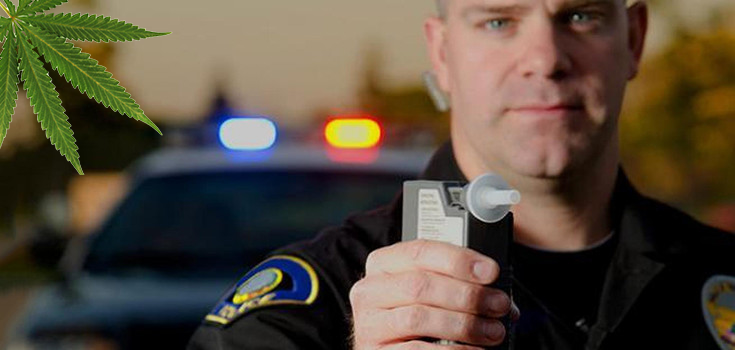Law Enforcement may Soon Have Breathalyzers to Measure Marijuana Impairment

Marijuana has been legalized in several states, leaving both drivers and law enforcement officials worried about people getting high and then getting behind the wheel. Current tests can tell cops whether an individual has smoked pot recently, but it can’t determine how impaired the person is. Law enforcement has to rely on behavior and appearance alone.
But a new invention will soon make it easier to law enforcement to weed out (pun intended) pot users who are too stoned to drive.
A marijuana breathalyzer manufactured by Oakland, California-based Hound Labs Inc. will be used in clinical trials early next year, the company announced earlier this month.
“The idea is that law enforcement will have one device out on the road to test for both THC [a marijuana component] and alcohol,” said Hound Labs CEO and founder Dr. Mike Lynn, an emergency room physician at Highland Hospital, in Oakland.
Levels of tetrahydrocannabinol (THC) – the psychoactive component in marijuana – are traditionally tested using urine, blood, or saliva. These tests can only show whether the person has used cannabis in recent days or weeks, but they’re fairly useless when it comes to measuring real-time impairment. They’re expensive and results can take days. [1]
“The issue was really all-around measurement,” said Lynn. “We need a way to not only test ‘yes’ or ‘no’ for the presence of marijuana, but to actually measure and correlate THC levels with impairment, like we have done for alcohol.”
The hand-held devices will cost around $1,000, about what the average alcohol breathalyzer costs.
According to the National Highway Traffic Safety Administration (NHTSA), it’s well-known that marijuana impairs psychomotor skills and cognitive function, but not much is known about how much cannabis you have to use before you become unsafe on the road. [2]
While Hound Labs’ breathalyzer isn’t the only one on the market, Lynn claims his company’s product is the only one that can give precise measurements in pictograms – measurements of one-trillionth of a gram that can determine exactly how stoned someone is at that moment. [3]
Even so, some states are not waiting to find out. In Washington and Montana, the set limit is 5 nanograms/milliliter (ng/mL) of blood, while Pennsylvania has set the limit at 1 ng/mL limit.
The new Hounds Lab device can measure THC levels from smoked pot, but can’t prove how impaired an individual is by itself.
“Our ability to measure THC in breath really should shift the national dialogue from one about simply detecting if THC is in someone’s body to a conversation where standards can be developed that reflect actual impairment,” Lynn said.
The new breathalyzer will be tested roadside by law enforcement agencies in the San Francisco Bay Area. If it proves useful, it could someday be used nationwide.
“Our ability to measure THC in breath really should shift the national dialogue from one about simply detecting if THC is in someone’s body to a conversation where standards can be developed that reflect actual impairment,” Lynn said.
Approximately 20 million Americans use marijuana. Some studies suggest its more common for young people to drive stoned than drive drunk.
The National Institute on Drug Abuse (NIDA) warns on its website that “marijuana significantly impairs judgment, motor coordination, and reaction time, and studies have found a direct relationship between blood THC concentration and impaired driving ability.”
A study funded partly by NIDA, the Office on National Drug Control Policy, and federal safety regulator, the National Highway Traffic Safety Administration published in August found that “alcohol, but not marijuana, increased the number of times the car actually left the lane and the speed of the weaving.”
Pot did, however, reduce drivers’ peripheral vision, giving them tunnel vision. At blood concentrations of 13.1 µg/L THC, drivers began weaving within the lane more, similar to those with 0.08 breath alcohol (the legal limit in all 50 states).
But there’s not much data showing how many car accidents are actually caused by marijuana impairment. While it certainly does impair drivers to a degree, Benjamin Hansen, an economist at the University of Oregon in Eugene and at the National Bureau of Economic Research, who has studied marijuana legalization in relation to driving accidents, told LiveScience that if people who would normally drink and drive instead chose to smoke and drive, it might be safer for the population as a whole.
Hansen specified that it’s always better to drive while you’re not drunk or stoned, but he pointed to a 2009 study in the American Journal of Addictions that showed cognitive impairments caused by marijuana are correlated with only modest reductions in driving performance in driving simulations.
Additionally, a 2013 study in the Journal of Law and Economics found that in the year after medical marijuana laws were passed, traffic fatalities actually fell.
Sources:
[1] CBS News
[2] Reuters
[4] CNN

You’re more likely to see Sasquatch or the ghost of the last honest politician than get a new blow meter to measure cannabis intoxication & impairment that’s accurate & certifiably honest. The first time they wave that thing around and say they’re “intoxicated on THC” and just watch the legal system come to life and lawyers get this thing put back in the box at least until it’s perfected. Just because a legal cannabis user has a high rate of metabolites in their system that doesn’t equal intoxication, let alone impairment. So until they can prove the subject is really intoxicated like an alcohol impaired driver, this govt black box won’t be ready for prime time until it can. And that’s a good thing…
clary sage and rosemary breaks the high know before you go.